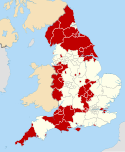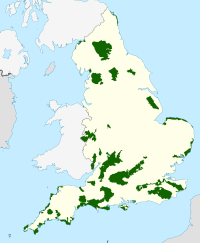Cornwall
Cornwall
Kernow (Cornish) | |
|---|---|
|
40th of 48 | |
| Density | 162/km2 (420/sq mi) |
| Ethnicity | |
| Unitary authority | |
| Council | Cornwall Council |
| Control | Conservative |
| Admin HQ | Lys Kernow, Truro |
| Area | 3,545 km2 (1,369 sq mi) |
| • Rank | 4th of 296 |
| Population (2022)[2] | 575,413 |
| • Rank | 5th of 296 |
| Density | 162/km2 (420/sq mi) |
| ISO 3166-2 | GB-CON |
| GSS code | E06000052 |
| ITL | TLK30 |
| Website | cornwall |
| Districts | |
 Districts of Cornwall | |
| Districts |
|
Cornwall (/ˈkɔːrnwɔːl, -wəl/;[4] Cornish: Kernow; Cornish pronunciation: [ˈkɛrnɔʊ]; or [ˈkɛrnɔ][5]) is a ceremonial county in South West England.[6] It is recognised by Cornish and Celtic political groups as one of the Celtic nations, and is the homeland of the Cornish people. The county is bordered by the Atlantic Ocean to the north and west, Devon to the east, and the English Channel to the south. The largest settlement is Falmouth, and the county town is the city of Truro.
The county is rural, with an area of 1,375 square miles (3,562 km2) and population of 568,210. After Falmouth (23,061), the largest settlements are Penzance, Newquay, St Austell, and Truro. For local government purposes most of Cornwall is a unitary authority area, with the Isles of Scilly having a unique local authority. The Cornish nationalist movement disputes the constitutional status of Cornwall and seeks greater autonomy within the United Kingdom.
Cornwall is the westernmost part of the
Cornwall had a minor Roman presence, and later formed part of the Brittonic kingdom of Dumnonia. From the 7th century, the Britons in the South West increasingly came into conflict with the expanding Anglo-Saxon kingdom of Wessex, eventually being pushed west of the Tamar; by the Norman Conquest Cornwall was administered as part of England, though it retained its own culture. The remainder of the Middle Ages and Early Modern Period were relatively settled, with Cornwall developing its tin mining industry and becoming a duchy in 1337. During the Industrial Revolution, the tin and copper mines were expanded and then declined, with china clay extraction becoming a major industry. Railways were built, leading to a growth of tourism in the 20th century. The Cornish language became extinct as a living community language at the end of the 18th century, but is now being revived.
Name
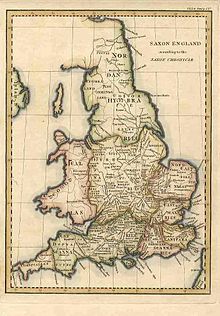

The modern English name "Cornwall" is a compound of two terms coming from two different language groups:
- "Corn-" originates from the
- "-wall" derives from Welsh).[12]
In the
History

Prehistory, Roman and post-Roman periods
Humans reoccupied
Cornwall in the Late Bronze Age formed part of a maritime trading-networked culture which researchers have dubbed the Atlantic Bronze Age system, and which extended over most of the areas of present-day Ireland, England, Wales, France, Spain, and Portugal.[13][14]
During the
The first written account of Cornwall comes from the 1st-century BC Sicilian Greek historian Diodorus Siculus, supposedly quoting or paraphrasing the 4th-century BCE geographer Pytheas, who had sailed to Britain:
The inhabitants of that part of Britain called Belerion (or Land's End) from their intercourse with foreign merchants, are civilized in their manner of life. They prepare the tin, working very carefully the earth in which it is produced ... Here then the merchants buy the tin from the natives and carry it over to Gaul, and after traveling overland for about thirty days, they finally bring their loads on horses to the mouth of the Rhône.[16]
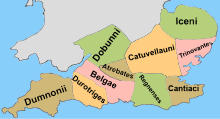
The identity of these merchants is unknown. It has been theorized that they were Phoenicians, but there is no evidence for this.[17] Professor Timothy Champion, discussing Diodorus Siculus's comments on the tin trade, states that "Diodorus never actually says that the Phoenicians sailed to Cornwall. In fact, he says quite the opposite: the production of Cornish tin was in the hands of the natives of Cornwall, and its transport to the Mediterranean was organized by local merchants, by sea and then overland through France, passing through areas well outside Phoenician control."[18] Isotopic evidence suggests that tin ingots found off the coast of Haifa, Israel, may have been from Cornwall.[19][20] Tin, required for the production of bronze, was a relatively rare and precious commodity in the Bronze Age – hence the interest shown in Devon and Cornwall's tin resources. (For further discussion of tin mining see the section on the economy below.)
In the first four centuries AD, during the time of
"King" Mark of Cornwall is a semi-historical figure known from Welsh literature, from the Matter of Britain, and, in particular, from the later Norman-Breton medieval romance of Tristan and Yseult, where he appears as a close relative of King Arthur, himself usually considered to be born of the Cornish people in folklore traditions derived from Geoffrey of Monmouth's 12th-century Historia Regum Britanniae.
Archaeology supports ecclesiastical, literary and legendary evidence for some relative economic stability and close cultural ties between the
Conflict with Wessex
The
The Anglo-Saxon Chronicle stated in 815 (adjusted date) "and in this year king Ecgbryht raided in Cornwall from east to west." this has been interpreted to mean a raid from the Tamar to Land's End, and the end of Cornish independence.
In 838, the Cornish and their Danish allies were defeated by Egbert in the
Eventually King Edgar was able to issue charters the width of Cornwall, and frequently sent emissaries or visited personally as seen by his appearances in the Bodmin Manumissions.
Breton–Norman period

One interpretation of the Domesday Book is that by this time the native Cornish landowning class had been almost completely dispossessed and replaced by English landowners, particularly Harold Godwinson himself. However, the Bodmin manumissions show that two leading Cornish figures nominally had Saxon names, but these were both glossed with native Cornish names.[34] In 1068, Brian of Brittany may have been created Earl of Cornwall, and naming evidence cited by medievalist Edith Ditmas suggests that many other post-Conquest landowners in Cornwall were Breton allies of the Normans, the Bretons being descended from Britons who had fled to what is today Brittany during the early years of the Anglo-Saxon conquest.[35] She also proposed this period for the early composition of the Tristan and Iseult cycle by poets such as Béroul from a pre-existing shared Brittonic oral tradition.[36]
Soon after the
Later medieval administration and society
Subsequently, however, Norman absentee landlords became replaced by a new Cornish-Norman ruling class including scholars such as
Stannary parliaments
The
Piracy and smuggling
Cornish piracy was active during the Elizabethan era on the west coast of Britain.[39] Cornwall is well known for its wreckers who preyed on ships passing Cornwall's rocky coastline. During the 17th and 18th centuries Cornwall was a major smuggling area.
Heraldry
In later times, Cornwall was known to the Anglo-Saxons as "West Wales" to distinguish it from "North Wales" (the modern nation of Wales).[40] The name appears in the Anglo-Saxon Chronicle in 891 as On Corn walum. In the Domesday Book it was referred to as Cornualia and in c. 1198 as Cornwal.[41][b] Other names for the county include a latinisation of the name as Cornubia (first appears in a mid-9th-century deed purporting to be a copy of one dating from c. 705), and as Cornugallia in 1086.
Physical geography

Cornwall forms the tip of the south-west peninsula of the island of
Coastal areas
The north and south coasts have different characteristics. The north coast on the Celtic Sea, part of the Atlantic Ocean, is more exposed and therefore has a wilder nature. The High Cliff, between Boscastle and St Gennys, is the highest sheer-drop cliff in Cornwall at 223 metres (732 ft).[43] Beaches, which form an important part of the tourist industry, include Bude, Polzeath, Watergate Bay, Perranporth, Porthtowan, Fistral Beach, Newquay, St Agnes, St Ives, and on the south coast Gyllyngvase beach in Falmouth and the large beach at Praa Sands further to the south-west. There are two river estuaries on the north coast: Hayle Estuary and the estuary of the River Camel, which provides Padstow and Rock with a safe harbour. The seaside town of Newlyn is a popular holiday destination, as it is one of the last remaining traditional Cornish fishing ports, with views reaching over Mount's Bay.

The south coast, dubbed the "Cornish Riviera", is more sheltered and there are several broad estuaries offering safe anchorages, such as at Falmouth and Fowey. Beaches on the south coast usually consist of coarser sand and shingle, interspersed with rocky sections of wave-cut platform. Also on the south coast, the picturesque fishing village of Polperro, at the mouth of the Pol River, and the fishing port of Looe on the River Looe are both popular with tourists.
Inland areas
The interior of the county consists of a roughly east–west spine of infertile and exposed upland, with a series of granite intrusions, such as Bodmin Moor, which contains the highest land within Cornwall. From east to west, and with approximately descending altitude, these are Bodmin Moor, Hensbarrow north of St Austell, Carnmenellis to the south of Camborne, and the Penwith or Land's End peninsula. These intrusions are the central part of the granite outcrops that form the exposed parts of the Cornubian batholith of south-west Britain, which also includes Dartmoor to the east in Devon and the Isles of Scilly to the west, the latter now being partially submerged.

The intrusion of the granite into the surrounding
The uplands are surrounded by more fertile, mainly pastoral farmland. Near the south coast, deep wooded valleys provide sheltered conditions for flora that like shade and a moist, mild climate. These areas lie mainly on Devonian sandstone and slate. The north east of Cornwall lies on Carboniferous rocks known as the Culm Measures. In places these have been subjected to severe folding, as can be seen on the north coast near Crackington Haven and in several other locations.
Lizard Peninsula
The
Hills and high points
Settlements and transport
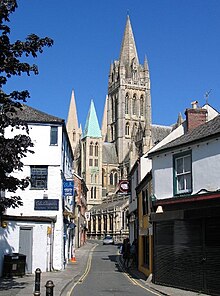
Cornwall's only city, and the home of the
Cornwall borders the county of
Cardiff and Swansea, across the Bristol Channel, have at some times in the past been connected to Cornwall by ferry, but these do not operate now.[46]
The
Ecology
Flora and fauna
Cornwall has varied habitats including terrestrial and marine ecosystems. One noted species in decline locally is the
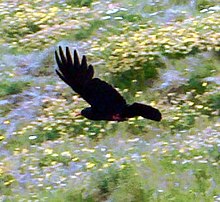
Botanists divide Cornwall and Scilly into two vice-counties: West (1) and East (2). The standard flora is by
Climate
Cornwall has a
Cornwall is one of the sunniest areas in the UK. It has more than 1,541 hours of sunshine per year, with the highest average of 7.6 hours of sunshine per day in July.[51] The moist, mild air coming from the southwest brings higher amounts of rainfall than in eastern Great Britain, at 1,051 to 1,290 mm (41.4 to 50.8 in) per year. However, this is not as much as in more northern areas of the west coast.[52] The Isles of Scilly, for example, where there are on average fewer than two days of air frost per year, is the only area in the UK to be in the Hardiness zone 10. The islands have, on average, less than one day of air temperature exceeding 30 °C per year and are in the AHS Heat Zone 1. Extreme temperatures in Cornwall are particularly rare; however, extreme weather in the form of storms and floods is common. Due to climate change Cornwall faces more heatwaves and severe droughts, faster coastal erosion, stronger storms and higher wind speeds as well as the possibility of more high impact flooding.[53]
Culture
Language
Cornish language

Cornish, a member of the
There has been a revival of the language by academics and optimistic enthusiasts since the mid-19th century that gained momentum from the publication in 1904 of Henry Jenner's Handbook of the Cornish Language. It is a social networking community language rather than a social community group language.[54] Cornwall Council encourages and facilitates language classes within the county, in schools and within the wider community.[55]
In 2002, Cornish was named as a UK regional language in the European Charter for Regional or Minority Languages.[56] As a result, in 2005 its promoters received limited government funding.[57] Several words originating in Cornish are used in the mining terminology of English, such as costean, gossan,[58] gunnies, kibbal,[59] kieve[60] and vug.[61]
English dialect
The Cornish language and culture influenced the emergence of particular pronunciations and grammar not used elsewhere in England. The Cornish dialect is spoken to varying degrees; however, someone speaking in broad Cornish may be practically unintelligible to one not accustomed to it. Cornish dialect has generally declined, as in most places it is now little more than a regional accent and grammatical differences have been eroded over time. Marked differences in vocabulary and usage still exist between the eastern and western parts of Cornwall.
Flag

Saint Piran's Flag is the national flag and ancient banner of Cornwall,[62][63][64] and an emblem of the Cornish people. The banner of Saint Piran is a white cross on a black background (in terms of heraldry 'sable, a cross argent'). According to legend Saint Piran adopted these colours from seeing the white tin in the black coals and ashes during his discovery of tin.[62][65] The Cornish flag is an exact reverse of the former Breton black cross national flag and is known by the same name "Kroaz Du".[66][67]

Arts and media
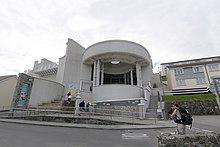
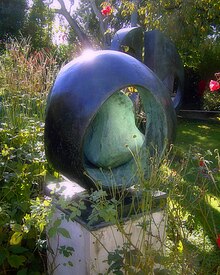
Since the 19th century, Cornwall, with its unspoilt maritime scenery and strong light, has sustained a vibrant visual art scene of international renown. Artistic activity within Cornwall was initially centred on the art-colony of
Local television programmes are provided by
Music
Cornwall has a
Newlyn is home to a food and music festival[79] that hosts live music, cooking demonstrations, and displays of locally caught fish.
As in other former mining districts of Britain, male voice choirs and
Cornish players are regular participants in inter-Celtic festivals, and Cornwall itself has several inter-Celtic festivals such as Perranporth's Lowender Peran folk festival.[80]
Contemporary musician Richard D. James (also known as Aphex Twin) grew up in Cornwall, as did Luke Vibert and Alex Parks, winner of Fame Academy 2003. Roger Taylor, the drummer from the band Queen was also raised in the county, and currently lives not far from Falmouth. The American singer-songwriter Tori Amos now resides predominantly in North Cornwall not far from Bude with her family.[81] The lutenist, composer and festival director Ben Salfield lives in Truro. Mick Fleetwood of Fleetwood Mac was born in Redruth.
Literature
Cornwall's rich heritage and dramatic landscape have inspired numerous writers.
Fiction
Sir Arthur Quiller-Couch, author of many novels and works of literary criticism, lived in Fowey: his novels are mainly set in Cornwall. Daphne du Maurier lived at Menabilly near Fowey and many of her novels had Cornish settings: The Loving Spirit, Jamaica Inn, Rebecca, Frenchman's Creek, The King's General (partially), My Cousin Rachel, The House on the Strand and Rule Britannia.[82] She is also noted for writing Vanishing Cornwall. Cornwall provided the inspiration for The Birds, one of her terrifying series of short stories, made famous as a film by Alfred Hitchcock.[83]
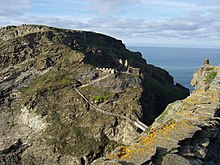
Medieval Cornwall is the setting of the trilogy by Monica Furlong, Wise Child, Juniper and Colman, as well as part of Charles Kingsley's Hereward the Wake.
Hammond Innes's novel, The Killer Mine;[86] Charles de Lint's novel The Little Country;[87] and Chapters 24–25 of J. K. Rowling's Harry Potter and the Deathly Hallows take place in Cornwall (Shell Cottage, on the beach outside the fictional village of Tinworth).[88]
David Cornwell, who wrote espionage novels under the name John le Carré, lived and worked in Cornwall.[89] Nobel Prize-winning novelist William Golding was born in St Columb Minor in 1911, and returned to live near Truro from 1985 until his death in 1993.[90] D. H. Lawrence spent a short time living in Cornwall. Rosamunde Pilcher grew up in Cornwall, and several of her books take place there.
St. Michael's Mount in Cornwall (under the fictional name of Mount Polbearne) is the setting of the Little Beach Street Bakery series by Jenny Colgan,[91] who spent holidays in Cornwall as a child.[92] The book series includes Little Beach Street Bakery (2014), Summer at Little Beach Street Bakery (2015), Christmas at Little Beach Street Bakery (2016), and Sunrise by the Sea (2021).
In the
Enid Blyton's 1953 novel Five Go Down to the Sea (the twelfth book in The Famous Five series) is set in Cornwall, near the fictional coastal village of Tremannon.
Poetry

The late
The poet
- They shall grow not old, as we that are left grow old
- Age shall not weary them, nor the years condemn
- At the going down of the sun and in the morning
- We will remember them
Other literary works
Cornwall produced a substantial number of
Thomas Hardy's drama The Queen of Cornwall (1923) is a version of the Tristan story; the second act of Richard Wagner's opera Tristan und Isolde takes place in Cornwall, as do Gilbert and Sullivan's operettas The Pirates of Penzance and Ruddigore.
The fairy tale Jack the Giant Killer takes place in Cornwall.[99]
The Mousehole Cat, a children's book written by Antonia Barber and illustrated by Nicola Bayley, is set in the Cornish village Mousehole and based on the legend of Tom Bawcock and the continuing tradition of Tom Bawcock's Eve.
Sports

The main sports played in Cornwall are rugby, football and cricket. Athletes from Truro have done well in Olympic and Commonwealth Games fencing, winning several medals. Surfing is popular, particularly with tourists, thousands of whom take to the water throughout the summer months. Some towns and villages have bowling clubs, and a wide variety of British sports are played throughout Cornwall. Cornwall is also one of the few places in England where shinty is played; the English Shinty Association is based in Penryn.
The
Truro, and all of the towns and some villages have
Rugby football
Viewed as an "important identifier of ethnic affiliation", rugby union has become a sport strongly tied to notions of Cornishness.[103] and since the 20th century, rugby union has emerged as one of the most popular spectator and team sports in Cornwall (perhaps the most popular), with professional Cornish rugby footballers being described as a "formidable force",[100] "naturally independent, both in thought and deed, yet paradoxically staunch English patriots whose top players have represented England with pride and passion".[104]
In 1985, sports journalist
In rugby league, Cornwall R.L.F.C., founded in 2021, will represent the county in the professional league system. The semi-pro club will start in the third tier RFL League 1.[105] At an amateur level, the county is represented by Cornish Rebels.
Surfing and watersports


Due to its long coastline, various maritime sports are popular in Cornwall, notably sailing and
Fencing
As its population is comparatively small, and largely rural, Cornwall's contribution to British national sport in the United Kingdom has been limited;[100] the county's greatest successes have come in fencing. In 2014, half of the men's GB team fenced for Truro Fencing Club, and 3 Truro fencers appeared at the 2012 Olympics.[107]
Cuisine
Cornwall has a strong culinary heritage. Surrounded on three sides by the sea amid fertile fishing grounds, Cornwall naturally has fresh seafood readily available;
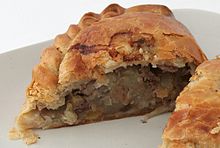
Cornwall is perhaps best known though for its
Local cakes and desserts include
There are also many types of beers brewed in Cornwall—those produced by Sharp's Brewery, Skinner's Brewery, Keltek Brewery and St Austell Brewery are the best known—including stouts, ales and other beer types. There is some small scale production of wine, mead and cider.
Politics and administration
Cornish national identity
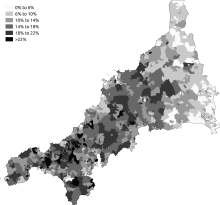
Cornwall is recognised by Cornish and Celtic political groups as one of six Celtic nations, alongside Brittany, Ireland, the Isle of Man, Scotland and Wales.[115][116][117][118] (The Isle of Man Government and the Welsh Government also recognise Asturias and Galicia.[119][120]) Cornwall is represented, as one of the Celtic nations, at the Festival Interceltique de Lorient, an annual celebration of Celtic culture held in Brittany.[121]
Cornwall Council consider Cornwall's unique cultural heritage and distinctiveness to be one of the area's major assets. They see Cornwall's language, landscape, Celtic identity, political history, patterns of settlement, maritime tradition, industrial heritage, and non-conformist tradition, to be among the features making up its "distinctive" culture.[122] However, it is uncertain exactly how many of the people living in Cornwall consider themselves to be Cornish; results from different surveys (including the national census) have varied. In the 2001 census, 7 per cent of people in Cornwall identified themselves as Cornish, rather than British or English. However, activists have argued that this underestimated the true number as there was no explicit "Cornish" option included in the official census form.[123] Subsequent surveys have suggested that as many as 44 per cent identify as Cornish.[124] Many people in Cornwall say that this issue would be resolved if a Cornish option became available on the census.[125] The question and content recommendations for the 2011 census provided an explanation of the process of selecting an ethnic identity which is relevant to the understanding of the often quoted figure of 37,000 who claimed Cornish identity.[126] The 2021 census found that 17% of people in Cornwall identified as being Cornish (89,000), with 14% of people in Cornwall identifying as Cornish-only (80,000).[127] Again there was no tick-box provided, and "Cornish" had to be written-in as "Other".[127][128]
On 24 April 2014 it was announced that Cornish people have been granted minority status under the European Framework Convention for the Protection of National Minorities.[129]
Local politics
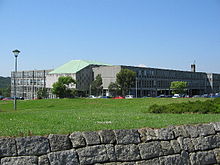
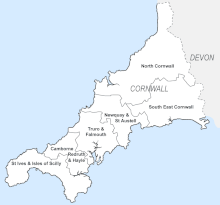
Cornwall forms two local government districts; Cornwall and the Isles of Scilly. The district of Cornwall is governed by Cornwall Council, a unitary authority based at Lys Kernow in Truro, and the Council of the Isles of Scilly governs the archipelago from Hugh Town.[130][131] The Crown Court is based at the Courts of Justice in Truro. Magistrates' Courts are found in Truro (but at a different location to the Crown Court) and at Bodmin.
The Isles of Scilly form part of the
Before reorganisation on 1 April 2009, council functions throughout the rest of Cornwall were organised in two tiers, with
The first elections for the unitary authority were held on 4 June 2009. The council has 123 seats; the largest party (in 2017) is the Conservatives, with 46 seats. The Liberal Democrats are the second-largest party, with 37 seats, with the Independents the third-largest grouping with 30.[139]
Before the creation of the unitary council, the former county council had 82 seats, the majority of which were held by the Liberal Democrats, elected at the 2005 county council elections. The six former districts had a total of 249 council seats, and the groups with greatest numbers of councillors were Liberal Democrats, Conservatives and Independents.
Parliament and national politics
Following a review by the
Before the 2010 boundary changes Cornwall had five constituencies, all of which were won by Liberal Democrats at the 2005 general election. In the 2010 general election Liberal Democrat candidates won three constituencies and Conservative candidates won three other constituencies. At the 2015 general election all six Cornish seats were won by Conservative candidates; all these Conservative MPs retained their seats at the 2017 general election, and the Conservatives won all six constituencies again at the 2019 general election.
Until 1832, Cornwall had 44 MPs—more than any other county—reflecting the importance of tin to the Crown.[140] Most of the increase in numbers of MPs came between 1529 and 1584 after which there was no change until 1832.[141]
Although Cornwall does not have a designated government department, in 2007 while Leader of the Opposition David Cameron created a Shadow Secretary of State for Cornwall. The position was not made into a formal UK Cabinet position when Cameron entered government following the 2010 United Kingdom general election[142]
Devolution movement
Cornish nationalists have organised into two political parties:
Emergency services
- Devon and Cornwall Police
- Cornwall Fire and Rescue Service
- South Western Ambulance Service
- Cornwall Air Ambulance
- HM Coastguard
- Cornwall Search & Rescue Team
- British Transport Police
Economy
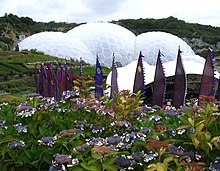
Cornwall is one of the poorest parts of the United Kingdom in terms of per capita GDP and average household incomes. At the same time, parts of the county, especially on the coast, have high house prices, driven up by demand from relatively wealthy retired people and second-home owners.[145] The GVA per head was 65% of the UK average for 2004.[146] The GDP per head for Cornwall and the Isles of Scilly was 79.2% of the EU-27 average for 2004, the UK per head average was 123.0%.[147] In 2011, the latest available figures, Cornwall's (including the Isles of Scilly) measure of wealth was 64% of the European average per capita.[148]
Historically
Today, the Cornish economy depends heavily on its tourist industry, which makes up around a quarter of the economy. The official measures of deprivation and poverty at district and 'sub-ward' level show that there is great variation in poverty and prosperity in Cornwall with some areas among the poorest in England and others among the top half in prosperity. For example, the ranking of 32,482 sub-wards in England in the index of multiple deprivation (2006) ranged from 819th (part of Penzance East) to 30,899th (part of Saltash Burraton in Caradon), where the lower number represents the greater deprivation.[151][152]
Cornwall was one of two UK areas designated as 'less developed regions' by the European Union, which, prior to Brexit, meant the area qualified for EU Cohesion Policy grants.[153] It was granted Objective 1 status by the European Commission for 2000 to 2006,[154] followed by further rounds of funding known as 'Convergence Funding' from 2007 to 2013[155] and 'Growth Programme' for 2014 to 2020.[156]
Tourism
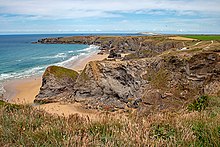
Cornwall has a tourism-based seasonal economy which is estimated to contribute up to[clarification needed] 24% of Cornwall's gross domestic product.[157] In 2011 tourism brought £1.85 billion into the Cornish economy.[158] Cornwall's unique culture, spectacular landscape and mild climate make it a popular tourist destination, despite being somewhat distant from the United Kingdom's main centres of population. Surrounded on three sides by the English Channel and Celtic Sea, Cornwall has many miles of beaches and cliffs; the South West Coast Path follows a complete circuit of both coasts. Other tourist attractions include moorland, country gardens, museums, historic and prehistoric sites, and wooded valleys. Five million tourists visit Cornwall each year, mostly drawn from within the UK.[159] Visitors to Cornwall are served by the airport at Newquay, whilst private jets, charters and helicopters are also served by Perranporth airfield; nightsleeper and daily rail services run between Cornwall, London and other regions of the UK.
Newquay and Porthtowan are popular destinations for surfers. In recent years, the Eden Project near St Austell has been a major financial success, drawing one in eight of Cornwall's visitors in 2004.[160]
In the summer of 2018, due to the recognition of its beaches and weather through social media and the marketing of travel companies, Cornwall received about 20 per cent more visitors than the usual 4.5 million figure. The sudden rise and demand of tourism in Cornwall caused multiple traffic and safety issues in coastal areas.[161]
In October 2021, Cornwall was longlisted for the UK City of Culture 2025, but failed to make the March 2022 shortlist.[162]
Fishing

Other industries include fishing, although this has been significantly re-structured by EU fishing policies (as of 2010[update] the Southwest Handline Fishermen's Association has started to revive the fishing industry).[163]
Agriculture
Agriculture, once an important part of the Cornish economy, has declined significantly relative to other industries. However, there is still a strong dairy industry, with products such as Cornish clotted cream.
Mining

Mining of tin and copper was also an industry, but today the derelict mine workings survive only as a World Heritage Site.[164] However, the Camborne School of Mines, which was relocated to Penryn in 2004, is still a world centre of excellence in the field of mining and applied geology[165] and the grant of World Heritage status has attracted funding for conservation and heritage tourism.[166] China clay extraction has also been an important industry in the St Austell area, but this sector has been in decline, and this, coupled with increased mechanisation, has led to a decrease in employment in this sector, although the industry still employs around 2,133 people in Cornwall, and generates over £80 million to the local economy.[167]
In March 2016, a Canadian company, Strongbow Exploration, had acquired, from administration, a 100% interest in the South Crofty tin mine and the associated mineral rights in Cornwall with the aim of reopening the mine and bringing it back to full production.[168] Work is currently ongoing to build a water filtration plant in order to dewater the mine.
Internet
Cornwall is the landing point for twenty-two of the world's fastest high-speed undersea and transatlantic fibre optic cables, making Cornwall an important hub within Europe's Internet infrastructure.[169] The Superfast Cornwall project completed in 2015,[170] and saw 95% of Cornish houses and businesses connected to a fibre-based broadband network, with over 90% of properties able to connect with speeds above 24 Mbit/s.[171]
Aerospace
The county's newest industry is aviation:
Demographics

Cornwall's population was 537,400 in the 2011 census, with a population density of 144 people per square kilometre, ranking it 40th and 41st, respectively,[clarification needed] among the 47 counties of England. Cornwall's population was 95.7% White British and has a relatively high rate of population growth. At 11.2% in the 1980s and 5.3% in the 1990s, it had the fifth-highest population growth rate of the counties of England.[173] The natural change has been a small population decline, and the population increase is due to inward migration into Cornwall.[174] According to the 1991 census, the population was 469,800.
Cornwall has a relatively high retired population, with 22.9% of pensionable age, compared with 20.3% for the United Kingdom as a whole.[175] This may be due partly to Cornwall's rural and coastal geography increasing its popularity as a retirement location, and partly to outward migration of younger residents to more economically diverse areas.[original research?]
Education


Over 10,000 students attend Cornwall's two universities, Falmouth University and the University of Exeter (including Camborne School of Mines). Falmouth University is a specialist public university for the creative industries and arts, while the University Of Exeter has two campuses in Cornwall, Truro and Penryn, the latter shared with Falmouth. Penryn campus is home to educational departments such as the rapidly growing Centre for Ecology and Conservation (CEC), the Environment and Sustainability Institute (ESI), and the Institute of Cornish Studies.
Cornwall has a comprehensive education system, with 31 state and eight independent secondary schools. There are three further education colleges:
See also
- Christianity in Cornwall
- Index of Cornwall-related articles
- Outline of Cornwall – overview of the wide range of topics covered by this subject
- Tamar Valley AONB
- Duchy of Cornwall
Notes
- ^ Eilert Ekwall who studied the place-names of England in the 1930s and 40s gives the following forms: Cornubia in Vita Melori &c.; Middle Welsh Cerniu; Welsh Cernyw; Cornish: Kernow; (on) Cornwalum ASC 891; Cornwealum ASC(E) 997; "The Brit name goes back to *Cornavia probably derived from the tribal name Cornovii. OE Cornwealas means 'the Welsh in Cornwall' this folk-name later became the name of the district".[11]
- Walhaz, meaning "Romanised foreigner"; through Old English welisċ, wælisċ, wilisċ, meaning "Romano-British"; to Modern English Welsh. The same etymology applies to Cornwall and to Wallonia in Belgium.[42]
- ^ Britain's only other example of an ophiolite, the Shetland ophiolite, is older, and linked to the Grampian Orogeny.
- ^ The Bodmin hurl is held whenever the ceremony of beating the bounds takes place: each occasion must be five years or more after the last one.
References
- ^ "No. 64352". The London Gazette. 22 March 2024. p. 5930.
- ^ a b "Mid-Year Population Estimates, UK, June 2022". Office for National Statistics. 26 March 2024. Retrieved 3 May 2024.
- Office for National Statistics. Retrieved 4 June 2024.
- ^ "Meaning of Cornwall in English". Oxforddictionaries.com. Archived from the original on 12 June 2021. Retrieved 3 March 2022.
- ^ Gerlyver Kernewek (FSS) Cornish Dictionary (SWF). Cornwall Council, Truro, Cornwall, UK. 2018. p. 95.
- ^ "Interpretation Act 1978: Schedule 1", legislation.gov.uk, The National Archives, 1978 c. 30 (sch. 1), retrieved 16 February 2024,
"England" means, subject to any alteration of boundaries under Part IV of the Local Government Act 1972, the area consisting of the counties established by section 1 of that Act, Greater London and the Isles of Scilly. [1st April 1974].
- ^ "Cornwall". Online Etymology Dictionary. Archived from the original on 27 September 2013. Retrieved 21 May 2013.
- ^ "Horn". Online Etymology Dictionary. Archived from the original on 27 September 2013. Retrieved 21 May 2013.
- ISBN 1-904880-00-2.
- ^ Charles Thomas. (1986). Celtic Britain. (Ancient Peoples & Places Series.) London: Thames & Hudson
- ^ Ekwall, E., The Concise Dictionary of English Place-names, 2nd ed., 1940, p. 117a.
- ^ "Cornish History – Stone Age to Present Day". www.cornwalls.co.uk. Retrieved 17 January 2022.
- ISBN 978-1-84217-410-4. Archived from the originalon 12 June 2010.
- S2CID 192963510.
- ^ Payton (2004), p. 40.
- ^ Halliday (1959), p. 51.
- ^ Halliday (1959), p. 52.
- .
- PMID 31242218.
- ^ Woodyatt, Amy (19 September 2019). "Ancient tin found in Israel has unexpected Cornish links". CNN. Archived from the original on 9 January 2020. Retrieved 16 March 2020.
- ISSN 2514-8362.
- ^ "ToposText". topostext.org. Retrieved 11 September 2023.
- ^ Fitzpatrick-Matthews, Keith (1 January 2022). "Britannia in the Ravenna Cosmography: a Reassessment". Academia.edu.
- ^ "AD 500 – Tintagel". Archaeology.co.uk. 24 May 2007. Archived from the original on 14 November 2013. Retrieved 24 November 2013.
- ^ ISBN 0859893553.
- ISBN 9781842173572.
- ^ "Medieval Sourcebook: The Annales Cambriae 447–954 (The Annals of Wales)". Fordham.edu. Archived from the original on 4 December 2010. Retrieved 2 November 2015.
- Weatherhill, CraigCornovia; p. 10
- ^ "The Foundation of the Kingdom of England". Third-millennium-library.com. Archived from the original on 5 October 2011. Retrieved 25 September 2010.
- ^ ISBN 978-1803990002.
- ^ Annales Cambriae
- ^ Keynes, Simon; Lapidge, Michael (tr.) (1983), Alfred the Great: Asser's Life of King Alfred and other contemporary sources, London, Penguin Books, p. 175; cf. ibid, p. 89
- ^ Stenton, F. M. (1947) Anglo-Saxon England. Oxford: Clarendon Press; p. 337
- ^ Cornish (and Other) Personal Names from the 10th Century Bodmin Manumissions Archived 11 May 2016 at the Wayback Machine by Heather Rose Jones
- ^ "Welsh Journals Online". Welshjournals.llgc.org.uk. Archived from the original on 31 December 2015. Retrieved 2 November 2015.
- ^ E. M. R. Ditmas, Tristan and Iseult in Cornwall: The Twelfth-century Romance by Beroul Re-told from the Norman French, by E. M. R. Ditmas Together with Notes on Old Cornwall and a Survey of Place Names in the Poem (Forrester Roberts, 1970)
- ^ Williams, Ann & Martin, G. H. (2002) (tr.) Domesday Book: a complete translation, London: Penguin, pp. 341–357
- ^ Payton (2004), chapter 5.
- ^ Matthew, David (July 1924). The Cornish and Welsh Pirates in the Reign of Elizabeth. Vol. 39. The English Historical Review: Oxford University Press. pp. 337–348.
- ISBN 978-0-7083-2032-7. Archivedfrom the original on 31 December 2015. Retrieved 16 October 2015.
- ISBN 978-0-521-16855-7.
- ISBN 978-0-14-028475-1.
- ^ "The Official Guide to the South West Coast Path". Southwestcoastpath.com. Archived from the original on 11 June 2011. Retrieved 25 September 2010.
- ^ "The Cornish Heath – County Flower". Archived from the original on 30 September 2008. Retrieved 5 February 2016.
- ^ "Town and parishes to get councils". BBC News website. BBC. 5 December 2008. Archived from the original on 6 December 2008. Retrieved 6 December 2008.
- ^ "Fast Ferries connecting Wales & the South West – Severn Link, Fast Ferries Connecting Wales and the South West". Severnlink.com. Archived from the original on 6 November 2015. Retrieved 2 November 2015.
- ^ Price, J. H., Hepton, C. E. L. and Honey, S. I. (1979). The Inshore Benthic Biota of the Lizard Peninsula, south west Cornwall: the marine algae – History; Chlorophyta; Phaeophyta. Cornish Studies; no. 7: pp. 7–37
- ^ Bere, Rennie (1982) The Nature of Cornwall. Buckingham: Barracuda Books
- ^ "UK climate information". Met Office. 1 May 2014. Archived from the original on 4 March 2010. Retrieved 2 November 2015.
- ^ "South West England: climate". Met Office. Archived from the original on 11 December 2018. Retrieved 18 March 2019.
- ^ "UK climate information". Met Office. 1 May 2014. Archived from the original on 4 March 2010. Retrieved 2 November 2015.
- ^ "UK climate information". Met Office. 1 May 2014. Archived from the original on 4 March 2010. Retrieved 2 November 2015.
- ^ "The impact of climate change - Cornwall Council". www.cornwall.gov.uk. Retrieved 25 October 2023.
- ^ "Cornish in United Kingdom". European Commission. Archived from the original on 12 October 2007. Retrieved 11 May 2007.
- ^ "Learning Cornish". Cornwall Council. 24 April 2020. Archived from the original on 28 July 2020. Retrieved 30 May 2020.
- ^ "November 2002 – Cornish gains official recognition". BBC News. 6 November 2002. Archived from the original on 10 October 2006. Retrieved 25 September 2010.
- ^ "June 2005 – Cash boost for Cornish language". BBC News. 14 June 2005. Archived from the original on 28 June 2006. Retrieved 25 September 2010.
- ^ "gossan – definition of gossan by the Free Online Dictionary, Thesaurus and Encyclopedia". Thefreedictionary.com. 21 September 2009. Archived from the original on 2 November 2012. Retrieved 24 October 2012.
- ^ "kibbal - Definition of kibbal - Online Dictionary from Datasegment.com". Onlinedictionary.datasegment.com. Archived from the original on 3 September 2015. Retrieved 24 October 2012.
- ^ Hunt, Robert (1887). British Mining: A Treatise on the History, Discovery, Practical Development. London: E. & F. N. Spon. p. 778. Archived from the original on 25 May 2017. Retrieved 8 November 2016.
The tin stuff is put into a "kieve" about 31⁄2 feet diameter and 21⁄2 feet deep, and with an equal volume of water is continually stirred with a shovel in one direction until the tin stuff is in a state of suspended motion.
- ^ Dictionary of Mining, Mineral, and Related Terms by American Geological Institute and U S Bureau of Mines; pp. 128, 249 & 613
- ^ a b Payton (2004), p. 262.
- ^ Rendle, Phil. "Cornwall – The Mysteries of St Piran" (PDF). Proceedings of the XIX International Congress of Vexillology. The Flag Institute. Archived (PDF) from the original on 30 April 2021. Retrieved 17 January 2010.
- ^ "Cross of Saint Piran". Flags of the World (FOTW). Archived from the original on 17 January 2007. Retrieved 17 January 2010.
- ^ Davies Gilbert in 1826 described it as anciently the flag of St Piran and the banner of Cornwall, and another history of 1880 said that: "The white cross of St. Piran was the ancient banner of the Cornish people."
- ^ "Cornwall (United Kingdom)". Crwflags.com. Archived from the original on 15 July 2010. Retrieved 25 September 2010.
- ^ "British Flags (United Kingdom) from The World Flag Database". Flags.net. Archived from the original on 5 November 2010. Retrieved 25 September 2010.
- ^ "Elizabeth Adela Forbes". PenleeHouse.org.uk. Archived from the original on 13 May 2007. Retrieved 11 May 2007.
- ^ "Samuel John Lamorna Birch". HayleGallery.co.uk. Archived from the original on 28 September 2007. Retrieved 11 May 2007.
- ^ "Virginia Woolf". The New York Times. Archived from the original on 9 December 2008. Retrieved 11 May 2007.
- ^ "Ben Nicholson". StormFineArts.com. Archived from the original on 30 December 2006. Retrieved 11 May 2007.
- ^ "Naum Gabo". Artnet.com. Archived from the original on 13 April 2007. Retrieved 11 May 2007.
- ^ "Bernard Leach and the Leach Pottery". Studio-Pots.com. Archived from the original on 3 April 2007. Retrieved 11 May 2007.
- ^ "Tate St Ives". Tate.org.uk. Archived from the original on 5 May 2007. Retrieved 11 May 2007.
- ^ "art and artists in Cornwall including Cornish galleries". art cornwall .org. Archived from the original on 4 July 2010. Retrieved 25 September 2010.
- ^ "BBC One - Spotlight". BBC. Retrieved 6 December 2022.
- ^ "ITV West Country Cornwall news for Bristol and the West Country". ITV News. Retrieved 6 December 2022.
- ^ "List of radio stations in the Cornwall". radio-live-uk.com. Archived from the original on 6 December 2022. Retrieved 6 December 2022.
- ^ "Newlyn fish festival". Newlynfishfestival.org.uk. Archived from the original on 15 October 2015. Retrieved 2 November 2015.
- ^ "An Daras Cornish Folk Tradition". An-daras.com. Archived from the original on 9 January 2016. Retrieved 2 November 2015.
- ^ Blackman, Guy (8 May 2005). "The whole Tori – Music – Entertainment". The Age. Melbourne. Archived from the original on 13 January 2009. Retrieved 25 September 2010.
- ^ "Daphne du Maurier". DuMaurier.org. Archived from the original on 6 February 2012. Retrieved 11 May 2007.
- ^ "The Birds". MovieDiva.com. Archived from the original on 9 August 2007. Retrieved 11 May 2007.
- ^ "The Adventure of the Devil's Foot". WorldwideSchool.org. Archived from the original on 13 January 2013. Retrieved 11 May 2007.
- ^ "Over Sea, Under Stone". Powell's Books. Archived from the original on 20 February 2007. Retrieved 11 May 2007.
- ^ "The Killer Mine". BoekBesprekingen.nl. Archived from the original on 8 October 2007. Retrieved 11 May 2007.
- ISBN 0312876491.
- ^ "Shell Cottage". hp-lexicon.org. Archived from the original on 30 December 2007. Retrieved 11 January 2008.
- ^ "Le Carré betrayed by 'bad lot' spy Kim Philby". Channel 4 News. London: Channel 4. 12 September 2010. Archived from the original on 8 July 2017. Retrieved 26 May 2011.
- ^ "Biography of William Golding". William-Golding.co.uk. Archived from the original on 17 March 2007. Retrieved 11 May 2007.
- ^ "Author Jenny Colgan reveals how Cornwall kick starts her creativity". www.visitcornwall.com. Archived from the original on 11 July 2022. Retrieved 11 July 2022.
- ^ McDonald, Sally (13 June 2021). "Bestselling author Jenny Colgan: I grew up by the sea, so it has always been part of my life and seems such a natural place to be". The Sunday Post. Retrieved 11 July 2022.
- ^ "Paddington". Paddington. Archived from the original on 24 November 2022. Retrieved 24 November 2022.
- ^ "St Enodoc Church". RockInfo.co.uk. Archived from the original on 13 June 2007. Retrieved 11 May 2007.
- ^ Woolf, Cecil (1965)."Hawker of Morwenstow, 1803–1875." The Book Collector; 14, no. 1 (spring): 62–71; 14, no. 2 (summer): 202–211.
- ^ "William Sydney Graham". CPRW.com. Archived from the original on 27 September 2007. Retrieved 11 May 2007.
- ^ Quoted in Croxford, Bob (1993) From Cornwall with Love. Mullion: Atmosphere; p. 22
- ^ "The 'Real' World of Saxton: From The Lost Crown". Darklingroom.co.uk. Archived from the original on 23 April 2011. Retrieved 5 January 2019.
- ^ "English Fairy Tales – Jack the Giant-Killer (by Joseph Jacobs)". www.authorama.com. Retrieved 24 January 2022.
- ^ a b c Clegg 2005, p. 10.
- ^ a b "Western League Premier Division (Step 5)", Non-League Matters, 7 May 2023. Retrieved 12 June 2023.
- ^ "Truro Promoted after dramatic play-off trophy final victory", Truro FC official site, 4 May 2023. Retrieved 12 June 2023.
- ISBN 978-0-415-22396-6.
- ^ a b Gallagher, Brendan (23 October 2008). "Cornish rugby union celebrate 125 years of pride and passion – but are they the lost tribe?". The Daily Telegraph. UK. Archived from the original on 27 October 2008. Retrieved 7 September 2009.
- ^ "Cornwall to host new rugby league team". BBC Sport. Retrieved 24 November 2022.
- ^ "Surfers aim to break world record". BBC News. 2 September 2007. Archived from the original on 2 December 2008. Retrieved 25 September 2010.
- ^ Pilnick, Brent (1 June 2012). "London 2012: Truro fencers dominate GB Olympic team". BBC Sport. Archived from the original on 1 July 2016. Retrieved 28 July 2016.
- ^ "Objective One media release". Objectiveone.com. Archived from the original on 14 July 2011. Retrieved 25 September 2010.
- ^ "Cornish recipe site". Alanrichards.org. 25 February 2008. Archived from the original on 11 October 2010. Retrieved 25 September 2010.
- ^ Martin, Edith (1929). Cornish Recipes, Ancient & Modern. 22nd edition, 1965.
- ^ "Official list of British protected foods". Europa.eu.int. 23 February 2009. Archived from the original on 2 June 2005. Retrieved 25 September 2010.
- ^ Mason, Laura; Brown, Catherine (1999) From Bath Chaps to Bara Brith. Totnes: Prospect Books
- ^ Pettigrew, Jane (2004) Afternoon Tea. Andover: Jarrold
- ^ Fitzgibbon, Theodora (1972) A Taste of England: the West Country. London: J. M. Dent
- ^ "Lords Hansard Text for 25 Jan 2011 (pt002)". Hansard. Parliament of the United Kingdom. 25 January 2011. Archived from the original on 21 November 2011. Retrieved 8 February 2011.
Cornwall sees itself as the fourth Celtic nation of the United Kingdom; Lord Teverson
- ^ "Mebyon Kernow – The Party for Cornwall – BETA". Mebyon Kernow website. Mebyon Kernow. 2007. Archived from the original on 28 September 2020. Retrieved 8 February 2011.
- Celtic League. 2011. Archivedfrom the original on 21 April 2019. Retrieved 8 February 2011.
- ^ "The International Celtic Congress". International Celtic Congress. 2009. Archived from the original on 25 July 2011. Retrieved 16 February 2010.
- ^ "Welsh Government: Minister in Paris for launch of Celtic festival". Welsh Government website. Welsh Government. 14 March 2002. Archived from the original on 10 March 2012. Retrieved 8 February 2011.
- ^ "Isle of Man Post Office Website". Isle of Man Government. 2009. Archived from the original on 2 August 2010. Retrieved 8 February 2011.
- ^ "Site Officiel du Festival Interceltique de Lorient". Festival Interceltique de Lorient website. Festival Interceltique de Lorient. 4 February 2011. Archived from the original on 5 March 2010. Retrieved 8 February 2011.
- ^ "Cornwall Council – part three". Cornwall Council website. Cornwall Council. 18 March 2010. Archived from the original on 28 May 2021. Retrieved 10 February 2011.
- ^ Dugan, Emily (6 September 2009). "The Cornish: they revolted in 1497, now they're at it again". London: Independent (The). Archived from the original on 19 August 2018. Retrieved 14 July 2010.
- ^ "Welsh are more patriotic". BBC. 3 March 2004. Archived from the original on 14 March 2007. Retrieved 14 July 2010.
- ^ "Information paper: Recommended questions for the 2009 Census Rehearsal and 2011 Census: National Identity" (PDF). Office for National Statistics. December 2008. p. 32. Archived (PDF) from the original on 2 March 2009. Retrieved 13 May 2009.
- ^ "2011 Census; 2011 census questionnaire content; question and content recommendations for 2011; ethnic group prioritisation tool" (PDF). Office for National Statistics. pp. 20–22. Archived (PDF) from the original on 10 January 2011. Retrieved 15 July 2010.
- ^ a b "Over 100,000 people identify as Cornish in latest census". Cornwall Live. 30 November 2022. Retrieved 6 December 2022.
- ^ "ONS update: 108,860 wrote "Cornish" on 2021 census". Mebyon Kernow website. 2 December 2022. Retrieved 8 December 2022.
- ^ "Cornish people granted minority status within UK". BBC. Archived from the original on 24 April 2014. Retrieved 24 April 2014.
- ^ "The Cornwall (Structural Change) Order 2008, part 2". legislation.gov.uk. Retrieved 21 June 2023.
- ^ "Contact us | Council of the ISLES OF SCILLY". scilly.gov.uk. Retrieved 21 June 2023.
- ^ "Cornwall Lieutenancy: Role and Responsibilities of the Lord-Lieutenant". Cornwall Council. Archived from the original on 12 September 2017. Retrieved 12 September 2017.
- ^ "Isles of Scilly; Cornwall through time". visionofbritain.org.uk. Archived from the original on 6 May 2007. Retrieved 19 January 2007.
- ^ "Isles of Scilly RD; Cornwall through time". visionofbritain.org.uk. Archived from the original on 6 May 2007. Retrieved 19 January 2007.
- Devon and Cornwall Police. Archived from the originalon 7 October 2009. Retrieved 23 September 2009.
- ^ "One Cornwall – A unified council for Cornwall". Cornwall County Council. Archived from the original on 1 May 2008. Retrieved 22 May 2008.
- ^ [1] Archived 11 October 2008 at the Wayback Machine
- ^ "Cornwall super-council go-ahead". BBC. 25 July 2007. Archived from the original on 19 May 2009. Retrieved 25 July 2007.
- ^ "Cornwall local election results 2017 are in and here are the highlights – Cornwall Live". 11 May 2017. Archived from the original on 11 May 2017. Retrieved 5 January 2019.
- ^ "British Archaeology, no 30, December 1997: Letters". Britarch.ac.uk. Archived from the original on 13 February 2011. Retrieved 25 September 2010.
- ^ Rowse, A. L. (1941) Tudor Cornwall. London: Cape; pp. 91–94
- ^ "'Fictional minister' prompts row". 17 March 2009 – via BBC News.
- ^ a b "Blair gets Cornish assembly call". BBC News. 11 December 2001. Archived from the original on 2 July 2008. Retrieved 22 May 2008.
- ^ Cornish Constitutional Convention (3 April 2005). "Campaign for a Cornish Assembly – Senedh Kernow". Cornishassembly.org. Archived from the original on 23 August 2014. Retrieved 25 September 2010.
- ^ Dugan, Emily (27 July 2008). "Cornwall: A land of haves, and have nots". The Independent. London. Archived from the original on 24 February 2014. Retrieved 15 May 2013.
- ^ ONS December 2006
- ^ Eurostat
- ^ "Cornwall economy slips back in fight with Europe's poorest". Western Morning News. 7 May 2014. Archived from the original on 11 May 2014. Retrieved 2 November 2015.
- ^ Halliday (1959), p. 69.
- ^ Halliday (1959), p. 182.
- ^ "cornwallstatistics.org.uk". 5 November 2015. Archived from the original on 5 November 2015.
- ^ [2] Archived 8 August 2007 at the Wayback Machine
- ^ "Cohesion Policy and the United Kingdom" (PDF). European Union. October 2014. Archived (PDF) from the original on 8 April 2016. Retrieved 28 March 2016.
For 2014–2020, the UK has been allocated around €11.8 billion (current prices) in total Cohesion Policy funding: €2.6 billion for less developed regions (Cornwall and the Isles of Scilly, West Wales and the Valleys).
- ^ "Impact Analysis: ESF Objective 1 Programme Cornwall and the Isles of Scilly, 2000–2006" (PDF). University of Exeter. South West of England Regional Development Agency. March 2008. Archived from the original (PDF) on 7 April 2016. Retrieved 27 March 2016.
Cornwall and the Isles of Scilly (IoS) received Objective One status in 1999, primarily as a consequence of their low Gross Domestic Product (GDP) per head (70.3% of the EU average). This resulted from a myriad of underlying socio-economic problems including the large number of people with relatively low levels of qualifications; with lack of basic skills beyond Level two being a particular problem.
- Department for Communities and Local Government. Archived (PDF) from the original on 9 October 2022. Retrieved 28 March 2016.]
The Convergence Programme for Cornwall and the Isles of Scilly will succeed the current Objective One Programme, which has been delivered with great effect by the key stakeholders. A total of €458.1 million has been allocated to the new Programme for 2007–13, which will be complemented by €196 million of Convergence ESF funding to support learning and skills related activities.
[permanent dead link - ^ "Cornwall Council – Business – Europe". Cornwall Council. 18 December 2015. Archived from the original on 25 March 2016. Retrieved 28 March 2016.
The Cornwall and the Isles of Scilly Growth Programme is worth €603,706,863 (excluding technical assistance) and is made up of two main funding streams: European Regional Development Fund (ERDF) -The ERDF Programme is worth €452,780,147 and makes up 75% of the Programme allocation and European Social Fund (ESF) – The ESF Programme is worth €150,926,716 and makes up 25% of the Programme allocation.
- ^ "Home Page – Cornwall Council". Db.cornwall.gov.uk. Archived from the original on 15 June 2008. Retrieved 2 November 2015.
- ^ "Tourist earnings top £9bn in Devon and Cornwall". Western Morning News. 21 December 2012. Archived from the original on 14 June 2015. Retrieved 2 November 2015.
- ^ "Tourism in Cornwall 1992 to 2007" (PDF). Visit Cornwall. 2007. Archived from the original (PDF) on 18 January 2012.. The total number of visitors to Cornwall includes those on business and visiting relatives.
- ^ Scottish Executive, 2004. A literature review of the evidence base for culture, the arts and sport policy Archived 15 December 2005 at the Wayback Machine.
- ^ "Heatwave leaves Cornwall so overcrowded it stops promoting beaches". The Independent. Archived from the original on 29 August 2018. Retrieved 29 August 2018.
- ^ "UK City of Culture 2025 Shortlist Revealed". Gov.UK. Retrieved 8 November 2022.
- ^ "Line-caught wild bass from Cornwall – South West Handline Fishermen's Association". Linecaught.org.uk. Archived from the original on 5 May 2009. Retrieved 25 September 2010.
- ^ "Cornwall and West Devon Mining Landscape – UNESCO World Heritage Centre". Whc.unesco.org. Archived from the original on 2 August 2020. Retrieved 2 November 2015.
- ^ "The University of Exeter – Cornwall Campus – Camborne School of Mines". Uec.ac.uk. Archived from the original on 4 July 2007. Retrieved 25 September 2010.
- ^ "Home". Cornish-mining.org.uk. 14 September 2010. Archived from the original on 19 April 2012. Retrieved 25 September 2010.
- ^ Imerys Minerals Ltd (2003) Blueprint: Vision for the Future
- ^ "Error". Archived from the original on 21 June 2018. Retrieved 14 August 2019.
- ^ "Submarine Cable Map". submarinecablemap.com. Archived from the original on 17 October 2017. Retrieved 4 September 2017.
- ^ Curtis, Sophie (24 July 2014). "Cornwall claims 'half' of UK's direct fibre broadband links". The Daily Telegraph. Archived from the original on 27 March 2016. Retrieved 18 March 2016.
- ^ "Superfast Cornwall Programme". Superfast Cornwall. Archived from the original on 21 March 2016. Retrieved 18 March 2016.
- ^ Rossiter, Keith (17 July 2018). "Aerohub to push ahead with satellite launches". The Western Morning News. p. 6.
Backers of the Spaceport Cornwall project said they had reached an agreement with Virgin boss Richard Branson to launch from Newquay Airport. Virgin Orbit will use a modified Boeing 747 to put satellites into low Earth orbit ... A partnership involving Cornwall Airport Newquay, Goonhilly Earth Station and ... has been bidding for Government cash to create a spaceport ... Newquay has a very long runway, a growing airport with national and international connections and easy access to uncongested airspace over the Atlantic. Its Aerohub Enterprise Zone offers hundreds of acres for developing the business and manufacturing that will support the spaceport.
- ^ Office for National Statistics, 2001. Population Change in England by County 1981–2000 Archived 30 June 2006 at the Wayback Machine.
- ^ Office for National Statistics, 2001. Births, Deaths and Natural Change in Cornwall 1974 – 2001 Archived 29 October 2006 at the Wayback Machine.
- ^ Office for National Statistics, 1996. % of Population of Pension Age (1996) Archived 30 June 2006 at the Wayback Machine.
Sources
- Clegg, David (2005). Cornwall & the Isles of Scilly: the complete guide (2nd ed.). Leicester: Matador. ISBN 1-904744-99-0.
- ISBN 0-7551-0817-5. A second edition was published in 2001 by the House of Stratus, Thirsk: the original text new illustrations and an afterword by Halliday's son
- ISBN 1-904880-00-2.
Further reading
- Balchin, W. G. V. (1954). Cornwall: an illustrated essay on the history of the landscape (The Making of the English Landscape). London: Hodder and Stoughton.
- Berry, Claude (1949). Cornwall (The County Books series). London: Robert Hale.
- Berry, Claude (1963). Portrait of Cornwall (The Portrait of (book series)). London: Robert Hale.
- Boase, George Clement; Courtney, William Prideaux (1874–1882). Bibliotheca Cornubiensis: a catalogue of the writings, both manuscript and printed, of Cornishmen, and of works relating to the county of Cornwall, with biographical memoranda and copious literary references. London: Longmans, Green, Reader, and Dyer. 3 vols.
- ISBN 0-575-02844-0, photographs by Christian Browning)
- ISBN 0-7100-7928-1. (Available online on Google Books).
- Graves, Alfred Perceval (1928). The Celtic Song Book: Being Representative Folk Songs of the Six Celtic Nations. London: Ernest Benn. (Available online on Digital Book Index)
- Koch, John T. (2006). Celtic culture: a historical encyclopedia. London: ABC-CLIO. ISBN 1-85109-440-7. (Available online on Google Books).
- ISBN 1-899526-60-9.
- Stoyle, Mark (2001). "BBC – History – The Cornish: A Neglected Nation?". BBC History website. BBC. Retrieved 25 May 2009.
- Stansfield-Cudworth, R. E. (2009). Political Elites in South-West England, 1450–1500: Politics, Governance, and the Wars of the Roses. ISBN 978-0-77344-714-1.
- Stansfield-Cudworth, R. E. (2013), "The Duchy of Cornwall and the Wars of the Roses: Patronage, Politics, and Power, 1453–1502", Cornish Studies, 2nd Series, 21: 104–50,
- Stoyle, Mark (2002). West Britons: Cornish Identities and the Early Modern British State. Exeter: University of Exeter Press. ISBN 0-85989-688-9.
- Williams, Michael, ed. (1973). My Cornwall. St Teath: Bossiney Books. ISBN 0-85989-688-9. (eleven chapters by various hands, including three previously published essays)
External links
- . Encyclopædia Britannica. Vol. 7 (11th ed.). 1911.
- The History of Parliament: the House of Commons – Cornwall, County, 1386 to 1831
- Online books, and library resources in your library and in other libraries about Cornwall





